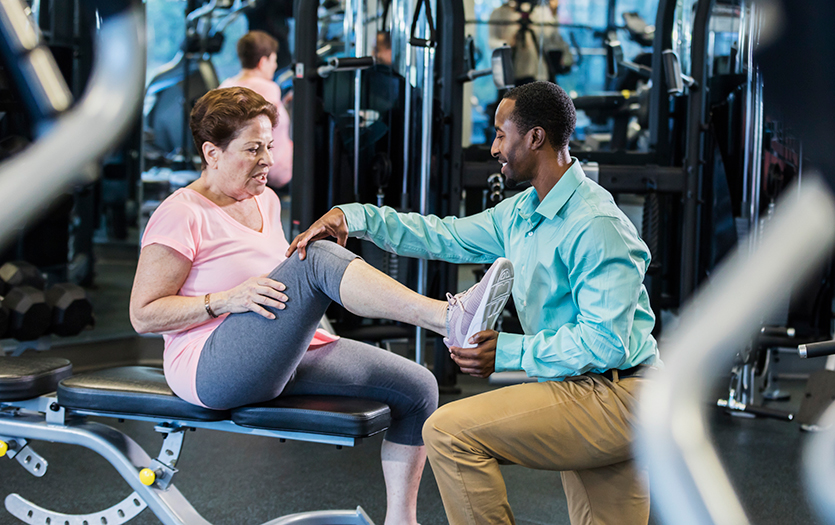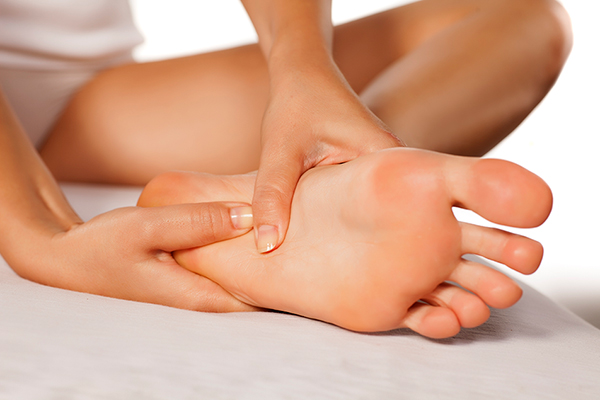
This post was written by Jithmie Jayawickrema, PT, DPT, OCS, and Sean Collins, PT, DPT, COMT, CEAS I, Therapy Services – Southwest, Parkview Health.
If you’re experiencing pain or stiffness in your knee, it could be caused by osteoarthritis. The most common form of arthritis, osteoarthritis doesn’t have a cure, but there are many treatments, including physical therapy, that can slow the progression of arthritis and ease your symptoms. Let’s dive into what osteoarthritis is and how physical therapy can be an important tool to conservatively manage it.
What is knee osteoarthritis?
Knee osteoarthritis is progressive degenerative articular cartilage loss. Cartilage is a cushion that allows your knee to move optimally by reducing friction and distributing the force throughout the joint. Osteoarthritis is when the cartilage wears down over time. What happens when this cartilage wears down? The space in your joint between your bones narrows, which can cause bones to rub together creating pain or a grinding or clicking sensation. While osteoarthritis can affect any joint, it is the most common type of arthritis to affect the knee joint.
There are two types of arthritis:
- Primary, which is the degeneration of articular cartilage without a known cause.
- Secondary or the degeneration of articular cartilage with a known cause such as post-trauma, post-surgery, rheumatoid arthritis, or congenital diseases.
Risk factors for osteoarthritis
Some people are at a higher risk for osteoarthritis and that risk increases as we age. These risk factors include:
- Previous trauma to the lower extremity
- Higher BMI
- Muscle weakness
- Occupation (for example, working a job that requires prolonged standing)
- Age
Signs and symptoms of knee osteoarthritis
How do you tell if you have osteoarthritis in your knee? These are common symptoms to watch for:
- Gradual onset of pain
- Knee stiffness
- Grinding/clicking
- Knee instability (giving out)
- Swelling at the knee
- Increased pain with prolonged walking, standing or climbing stairs
Diagnosing knee osteoarthritis
Primarily, osteoarthritis in the knee is diagnosed with imaging. The x-ray is considered the gold standard in diagnosing osteoarthritis. However, diagnosis is also based on a thorough physical exam that includes:
- Knee range of motion
- Palpation of the knee joint
- Gait mechanics
- Observation of swelling
- Quadriceps muscle atrophy (loss of muscle)
- Malalignment of knee (varus/valgus changes)
Physical therapy for knee osteoarthritis
Physical therapists are key providers in the conservative management of knee osteoarthritis. In a 2022 study it was found that exercise was ranked as the “best” treatment intervention amongst a study looking at exercise, NSAIDs, opioids, and a control intervention in the management of knee osteoarthritis pain.
A physical therapy plan for knee osteoarthritis could include:
- Manual therapy to address joint and soft tissue restrictions
- Therapeutic exercise to improve:
- Knee range of motion (stretching quadriceps, hamstrings, and calf muscles)
- Quadriceps strength (knee extensions, leg press, straight leg raises, and mini lunges)
- Hip strength (bridging, standing leg raises, lateral step ups, sit to stands at a chair)
- Neuromuscular training
- To improve joint proprioception (the sense of joint position)
- Assist with balance activities
- Other modalities
- Taping
- Recommendations on bracing
- Patient education
- Activity modification (advice on how to stay active while keeping pain at a minimum)
- Progressive loading
- Management of flare ups
- Swelling management
Current evidence shows that exercise should be a part of treatment for osteoarthritis. Since knee osteoarthritis causes activity-related pain, it is important that exercise is structured and individualized to prevent further pain that can cause a patient to remain inactive. Aquatic therapy is a great option to offload joints if your pain is too severe to exercise on land. You could then transition to land-based exercise once your pain is better managed.
A diagnosis of osteoarthritis can feel daunting, and it can be easy to get caught up in your radiography findings. But physical therapy can be an effective tool for reducing your symptoms. Talk to your physical therapist about an individualized treatment program that is specific to your current condition. For more information, or to schedule with one of our expert physical therapists at any of our locations, call 260-266-7400.
References
- https://www.ncbi.nlm.nih.gov/books/NBK507884/
- https://www.sciencedirect.com/science/article/pii/S106345841601058X?via%3Dihub
- https://www.jospt.org/doi/10.2519/jospt.2018.7877
- https://www.jospt.org/doi/10.2519/jospt.2022.10490



